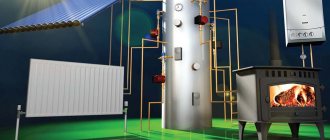Application area
A time relay is a device designed to turn on/off devices and control processes at a certain period of time.
Such equipment is quite often used in industry to control production processes without human intervention. Relays are no less often used in everyday life. It can be used for systematic watering, turning on lighting at certain times, etc.
Electronic microprocessor time relay model PCR-513 can be programmed by the user
Types and classification
Devices such as time relays are divided into:
- block;
- modular;
- built-in
Block ones differ in the specific installation process, which requires individual power supply from the network. Built-in ones do not require a separate power supply, as they are most often used as auxiliary elements in more complex circuits. Modular time relays are also not connected to a separate power line. Modular relays are mounted on a DIN rail.
Time relays can also be:
- electromagnetic;
- pneumatic;
- electronic;
- motor.
Electronic or electromagnetic relays are mainly used for household use. This is explained by the fact that they are as efficient as possible, and their cost is low and affordable for any consumer.
Functions and characteristics of lighting control timers.
The main thing you should pay attention to when purchasing is the maximum permissible switched load.
Which is easy to calculate by simply adding up the power that you plan to connect to the timer. To convert to Amperes, divide the Watts by the operating voltage of 220 Volts. When purchasing, it is very important to pay attention to the type of fastening. which can be placed under the Din rail of the electrical panel, and the timer can also be designed for built-in installation inside a wall or overhead. Third is the operating temperature range
which is important when installing in unheated places.
According to the type of control, they are divided into: mechanical (Figure 1) and more accurate and functional electronic (Figure 2 and 3). There are models of switches with a built-in timer for entrances (Figure 4), which, after pressing, turn on and off after a specified number of seconds. Timers are available to control one channel or two, as well as multi-channel (Figure 3). Two-channel allows you to separately configure and control the main and auxiliary lighting. When purchasing, please note that the timer can only have a weekly or annual program. More expensive models almost always have all kinds of programs, including weekends. Pay attention to the astronomical timer. which allows, after setting the location coordinates, to automatically adjust the time of sunset and dawn taking into account changes in the length of the day during the year.
There are other unimportant characteristics. Such as, for example, time accuracy, minimum time setting (usually up to a minute), etc.
Advantages and disadvantages of the device
Electronic relays have the advantage that they perform their functions with high precision. The only negative quality that can be noted is that they require precision in programming; the time interval that can be set is significantly less than that of electromechanical ones. It is also worth noting the fairly high cost.
The main advantages of electromagnetic relays are their low price; they do not require constant maintenance, regular programming, or changing settings. The disadvantage of such devices is their limited service life, as well as not very good operation with direct current.
Time relays on the modern market are presented in a wide variety of types and models
Timer for pump control Meander entertaining electronics
The device, the circuit of which is shown in the figure, periodically generates pulses of positive polarity at the output (at pin 11 of the DD1 microcircuit). It contains two IC generators operating alternately (on elements DD1.1 and DD1.2), a switch on element DD1.3, a serial circuit of four counters of microcircuits DD2, DDЗ, an inverter on element DD1.4 and an electronic relay on transistor VT1 and electromagnetic relay K2, which controls the operation of magnetic starter K1. The duration of the pulses (Ton) and pauses between them (Toff) depends on the frequency of the pulses generated by the pulse generators and the counter outputs used and can be adjusted within wide limits.
When the device is connected to the network, a constant supply voltage appears at the output of rectifier VD1 and, thanks to circuit R3C3, the counters of microcircuits DD2, DD3 are set to zero. In this case, a log level appears at the output of inverter DD1.4. 1 and the generator on element DD1.2 is switched on. At the same time, transistor VT1 opens, relay K2 is triggered and with its contacts K2.1 it connects the winding of the magnetic starter K1 to the network, as a result of which it also triggers and with contacts K1.1, K1.2 it connects the load to the network. From the output of element DD1.3, pulses with the repetition rate of this generator are supplied to the CN input (pin 2) of the first counter of the DD2 microcircuit. The countdown begins.
With the advent of log. 1 at the counter output (pin 14 DD3) logic level. 1 at the output of element DD1.4 is replaced by a log level. 0, transistor VT1 closes, de-energizing relay K2, it releases and breaks the power circuit of the magnetic starter K1, which, in turn, turns off the load. At the same time, the generator on element DD1.1 is turned on, pulses with the frequency of this generator begin to arrive at the CN input of the first counter of the DD2 microcircuit - the countdown of the Toff time begins, after which everything is repeated from the beginning.
In practice, the device has been used for four years to control, according to a given cycle, a water pump with a capacity of 2500 l/h, pumping water from a well with a flow rate of 300 l/h. For the ratings of the elements R1, R2, C1 and C2 indicated in the diagram, the pump is turned on for a time Ton = 151 s = 2 min 31 s, pumps out about 130 liters of water into the storage tank, and then turns off for a time Toff = 27 min, during which water accumulates in the well. The need to control a pump with such a cycle is due to the fact that without washing with water, the pump fails. The device is powered from an unstabilized source containing a step-down transformer T1 with a secondary winding of 9 V and a rectifier bridge KTs405A. To control the K1 starter, relay K2 is used with a winding resistance of about 700 Ohms and a rated voltage of 12 V.
Principle of operation
The operating principle of a time relay is as follows.
Since these are devices that count time, each of them has a timer that is set for a certain period. Therefore, it is necessary to set the timer for the required on or off time. The timer is built into the front of the device. Depending on the specified characteristics, this device will turn off the power supply and turn it on at a certain time. This cycle will continue until the relay is switched to rest.
A time relay, regardless of its design and characteristics, can be set from one second to 999 hours.
Specifications
All devices that are used in the electrical network must have their characteristics consistent with its parameters, that is, the conditions under which their operation will be stable must be met.
Regardless of the type and specific model, time relays are characterized by the following parameters:
- the voltage at which this device will operate stably;
- switching current, which determines the control current of the device;
- wear resistance, determined by the number of switches on or off and is more suitable for electromagnetic relays;
- type of protection;
- number of contacts;
- device power, indicating the maximum load this device can switch without connecting a contactor.
Based on these data, you can select a device with the required characteristics for certain parameters of the serviced electrical network.
Daily/weekly timer
A device that operates according to a pre-set program. It is used to control processes in automation systems, both in everyday life and in production.
How the timer works
Such a programmable timer allows you to control the load in both daily and weekly modes. You can choose suitable time intervals, as well as an arbitrary number of on and off (a good indicator is at least 200). Modern timers “know what weekends and weekdays are.”
Well, we’ve briefly talked about this device, and now let’s move on to the topic of using it in tandem with an electric boiler to heat a room. The thing is that there are day and night tariffs for the use of electricity by citizens of Ukraine. And the night rate is a reduced rate (from 23:00-7:00). And if your electric boiler is paired with a timer, then you can easily program it for different operating modes during the day, evening and night. For example, if you are not at home during the day (you are at work, children are at school, kindergarten), the timer program will switch your boiler to the minimum you need. And by the time you return home, the other team will switch the boiler to the maximum that suits you. Again, during the night the apartment (house) will have time to heat thoroughly. The logic is clear and understandable, and the saving of your money, so to speak, is obvious. But they can say, and quite rightly, that now there are electric boilers with a built-in timer. Yes, this is true, but... there are different situations.
Situations.
For example, someone already has an electric boiler (without a timer) and the boiler’s service life has not yet expired, and in general, the owner is happy with everything, “if only they could add a timer.” Or, someone who has an electric boiler plans to switch to gas heating over time, but now wants to take advantage of a preferential tariff. Also an option. Also, an electric boiler can perfectly serve as a backup heat source, you never know. All such situations require a device such as a weekly (daily) timer to be solved.
What else can I mention?
Perhaps it would not be amiss to say where else this device can be used. And it can be used in the control of lighting devices, refrigeration units, ventilation equipment, etc., when their work needs to be regulated by time frames (intervals). And, as we said above, this device can also be used in production.
Note.
Good timers have an autonomous power supply to maintain the functionality of the program in case of power failure, as well as automatic transition to summer and winter time. Therefore, if you decide to buy a daily/weekly timer, then you already know what to focus on.
Need advice! What is more correct and better, from the point of view of ease of use, to connect a 4.5 kW electric boiler, according to scheme 1 or 2? Contactor - » > VN - load switch for 32A, IEK. Socket with timer Feron TM50 16A, 3500W.
P.S. Everything - automatic machines, RCDs, etc., are located in the input panel, here we are only talking about connecting the boiler.
I like this one, but I would like it
The first circuit, only instead of VN-32, use AB 1A contactor coil to protect it.
And such a moment. A 16A socket is connected to the 2x4 cable, and therefore the circuit breaker on the 2x4 cable should also be no more than 16A.
VN, because it will be used as a switch, just so as not to pull the plug from the timer every time. But clicking the machine back and forth is not advisable. I’ll probably add an automatic machine in sequence, but on 1A it’s exotic and . price.
Well, basically yes, I didn’t notice, thank you!! What should I do?
How to read labels
When labeling such devices, manufacturers try to simplify readability as much as possible. The manufacturer and model of the device are initially indicated on the case. The voltage suitable for normal operation of the device is also indicated. In most cases it is 220 V.
It is also marked for what magnitude and type of current (direct or alternating) the device is suitable for operation. The appliance must also indicate the maximum load current for the particular appliance.
Almost all time relays have terminal markings and a designation for zero and phase connections.
Manufacturer analysis
Timing relays are manufactured by many manufacturers with factories located throughout the world. The table below shows the most popular models in our country, indicating the manufacturers and type of device mounting.
| Model | Manufacturer country | Company name | Fastening |
| RVTs-10/D | Ukraine | UKR RELAY | DIN rail |
| TR4N 4CO | Poland | Relpol | DIN rail |
| TM M1 | Italy | LOVATO Electric | DIN rail |
| IO 1080/IO | Italy | Perry | DIN rail |
| LT4H-AC240VS | Malaysia | Panasonic | To panel |
Time relay connection diagrams
No complex circuits are used to connect the time relay. When installing it, it is important to know what load it will switch.
This circuit allows you to perform various operations by turning on/off the relay in normal mode
The connection diagram presented above is used in most cases for home use. This scheme ensures stable operation of the device. The only drawback is that the time relay can only be connected to one line with a small load. For example, street lighting or watering the lawn.
Connection diagram of a time relay to a network with electrical appliances with a significant load
A circuit with a contactor is used in cases where it is necessary to disconnect a more powerful load. Its use in everyday life can also be often found. In it, the role of a switching device for a more powerful load is played by a contactor. Such a circuit can control, for example, the operation of an asynchronous motor. It is also used if it is necessary to switch a more powerful load using a low-power time relay.
Connection diagram of an ERF-09 time relay to a three-phase network via a contactor
The time relay can also be connected in a three-phase network. The diagram presented above clearly demonstrates this. It is used in places with three-phase voltage. The main switching device is a contactor, which is controlled by a time relay.
Step-by-step installation instructions
In order to independently connect a time relay, you need to decide on which network the installation will take place. It can be single-phase or three-phase. You also need to know in advance what this device will switch, that is, what load needs to be turned off or on.
Based on this data, you need to purchase a device with the required characteristics, or any available one, but you also need to purchase a contactor complete with it.
Tip No. 1: Before installing the time relay, it is necessary to de-energize the entire electrical network for safe work. This is done using an input machine.
The time relay is installed after the electricity meter. At the next stage, using the device’s passport data, it is necessary to determine where its input and output are. The input is the terminals to which you want to connect the wire. Output - these are the terminals from which the switching voltage will come out.
16A continuous pulse time relay is often used in households
Tip #2: Before installation, you also need to check the device for functionality. This must be done before the power goes out.
To do this, you need to connect a cord with a plug to the device according to a given diagram and set the minimum response time. Using a tester, the presence of voltage is checked at the output contacts.
Before connecting, the time relay must be installed securely. Most of these devices are mounted on a DIN rail. After installation, connection is made. The tension of the bolts should be maximum, since if the contact is poor, the device will heat up and can quickly fail, or even worse, it can cause a fire.
Digital timer for pump CAVR.ru
Share in:
The process is fully automated, and there is no need to constantly monitor the water level in the tank - the device controls and maintains the specified water level in the tank. The use of a microcontroller made it possible to increase its reliability, as well as to build a small-sized and easily repeatable design.
Rice. 1
The timer circuit is shown in Fig. 1. The clock frequency of the ATtiny2313 (DD1) microcontroller is set by an external quartz resonator ZQ1. The duration of continuous operation of the pump and the duration of the pause from turning it off to turning it on again are set using two buttons (SB1 and SB2)
These values are stored in the microcontroller's non-volatile memory, so there is no need to reset them after each power cycle, which is especially important in rural areas. When the power is restored, the timer begins its work with a pause, which protects the pump from failure as a result of repeated switching on and off in a short period of time
During the timer operation, two three-digit seven-element LED indicators with common cathodes (HG1, HG2) display the time remaining until the pump turns on (when pausing) or until it turns off (during water supply). Indication is dynamic. The DD2 decoder with outputs made according to the “open collector” circuit converts the three-digit binary code of the familiarity number generated by the microcontroller into signals supplied to the cathodes of the indicators for their turn-on. The pump also stops when the maximum level sensor SF1 is triggered. This is accompanied by the display of the inscription FULL on the indicator. The sensor can be any microswitch equipped with a lever with a float. For greater reliability, you can install another microswitch that breaks the power supply circuit of the timer if the SF1 sensor does not work for any reason.
Rice. 2
All parts of the device, except for the SF1 sensor, are mounted on a printed circuit board made of fiberglass foil on both sides, shown in Fig. 2. In its original version, unused sections of foil on both sides of the board are connected to the -(9...12) V circuit and serve as an additional common wire. The board is designed for surface-mount parts (except for the quartz resonator ZQ1, stabilizer DA1, indicators HG1, HG2, buttons SB1, SB2 and relay K1). Relay type - JRC-23F. Its coil resistance is 167 Ohms, operating voltage is 5 V. The contacts are designed for switching alternating voltage up to 125 V with a load power of no more than 62.5 VA. A pump or other actuator whose power exceeds the capabilities of this relay can be turned on using another relay or contactor rated for the appropriate current and voltage. Relay K1 in this case will serve as an intermediate one.
Rice. 3
The board also has an XP1 pin connector, the contacts of which are connected to the pins of the microcontroller according to the diagram in Fig. 3. It is designed to connect the programmer to a microcontroller already installed on the board. The table shows how the microcontroller configuration bits should be programmed. They specify its operation with a quartz resonator with a frequency of more than 8 MHz and a program start delay of 16,000 cycles. To protect information in the EEPROM of the microcontroller from accidental damage during the rise of the supply voltage, the response threshold of the internal voltage detector (BODLEVEL) is set to 1.8 V.
When loading codes from the Pump-Control.hex file available in the application into the microcontroller's program memory, the pump operating time and pause duration can be independently changed from 0 to 60 minutes in 1-second increments. The timer consumes a current of no more than 500 mA from a voltage source of 9...12 V.
The timer microcontroller program can be downloaded here
Leave your comment or question:
Installation errors
The main mistake is connecting a time relay to devices with too much load, for example, an electric boiler. To control the heater, it is necessary to connect a relay through a magnetic starter connected to the boiler.
Also, no less often, time relays are installed in rooms with climatic conditions that are not suitable for normal operation of the device. The temperature should be in the range of -20 - 50°C with a humidity not exceeding 80%.
- Installing a magnetic starter (diagram)
- What is a power limiter (application)
- UZM-3-63 protection device and connection diagram
- How to choose a circuit breaker by power, current, pole
- Installing a power limiter (diagram)
How to connect an electric boiler
An electric boiler is the best in terms of comfort - it does not require maintenance, it is the most reliable, and replacing a burnt-out heater costs pennies. It is programmable, almost silent, compact, and can be installed anywhere. Let's look at how to connect and operate it...
- In terms of comfort, the electric boiler has no equal - “press the button and forget it”, no need to approach it at all. It is because of this that electric boilers are increasingly being installed as the main heat generator.
- An electric boiler is considered the best backup because of its reliability. Its experts recommend installing it with any other - gas, solid fuel, liquid fuel...
But the price of electricity plays a key role. In most cases, the electric boiler remains a backup or temporarily switched on. Its heat will cost 5 times more than from gas or coal. True, it is possible to reduce the price quite significantly under certain circumstances, which we will consider below. But first of all - how to connect an electric boiler...
What cable for the boiler, what cross-section of conductors
The power of a two-phase electric boiler (designed for 220 V) is up to 7 kW, more often 3 – 6 kW. The power of three-phase 380 V is usually from 6 to 20 kW. When connecting, you must strictly comply with the requirements of the regulations.
The electric boiler is connected directly to the switchboard with a separate cable. The required cross-section of the cores for the boiler will be indicated in its instructions. You can use general recommendations if you know the maximum power of the device. A fragment of a table from the PUE for choosing the cross-section of copper conductors...
For a 5 kW boiler at 220 V, connection with a 2.5 mm2 conductor, maximum current up to 25 A and power up to 5.5 kW is allowed. For a 6 kW boiler at 220 V, it is recommended to connect it with a conductor with 4 mm2 copper conductors.
At 380 V, a 10 kW boiler requires a five-core cable with a copper core cross-section of at least 2.5 mm2, but for a 15 kW boiler it is recommended to use a cable with copper cores from 4.0 mm2. General recommendations are in the table.
Three-core cables of the PVV type or similar are used for 220 V, and five-core cables for 380 V, laid in accordance with the requirements of the regulations.
What protection is required - circuit breaker
For an electric boiler, maximum current protection is additionally installed on the panel - a circuit breaker. A machine with a small overload capacity, class B, is recommended, since there are no large starting currents characteristic of electric motors. The machine is selected based on current. Recommendations for selecting a circuit breaker according to current for 220 V and copper cable are given in the table.
For example, for a 5 - 6 kW 220 V boiler, a switch for a current of 32 A is recommended.
General circuits for switching on electric boilers at 220V and 380V.
Leak relay
Protection against current leakage to ground (protective shutdown) must be installed. Recommended differential operating current is 30 mA.
(The earth leakage relay evaluates the current difference between all connected phases. If an earth leakage occurs anywhere in the circuit, then a current difference occurs between the phases - a differential value. The device registers this and turns off the network, and the response time is short, such that when a person touches a conductor, a current of dangerous magnitude does not have time to develop through the body...)
- Differential circuit breakers can be installed - devices that combine maximum current protection and a protective relay in one housing. An example of selecting a difavtomat for boilers depending on their power for a voltage of 380 V is given in the table.
Connecting heating elements in an electric boiler
Each boiler is supplied by the manufacturer with a schematic electrical diagram, which includes, among other things, a rewiring diagram if the boiler will be used with a different supply voltage.
Boilers designed to operate on a 220 V network are also equipped with heaters with an operating voltage of 220 V, which are connected in parallel. An example of an electrical installation diagram for an electric boiler on a 220 V network with 3 heaters, each of which is turned on by a separate switch, is shown in the figure.
Boilers for 380 V can be equipped with heaters designed for 220 V. Then the heaters are connected according to a star circuit with a common zero.
If the heaters are designed for a voltage of 380 V, then they are connected in a triangle.
How to connect an electric boiler to heating. Hydraulic diagrams.
In the simplest version, the electric boiler is connected to the heating system just like any other. The safety group, circulation pump, and expansion tank may already be included in the boiler itself (expensive models).
If the electric boiler is used only as a reserve for any boiler, then it is much more advisable to provide manual activation through valves, without using check valves. A simple scheme for backing up any other electric boiler.
To use the boiler “on the fly,” it turns on when the main solid fuel burns out and the temperature of the air or coolant decreases, which is registered by the corresponding relay (thermostat). The circuit for turning it on together with the solid fuel must necessarily turn off the solid fuel pump as soon as there is no longer a flame present in it, so that it does not act as a cooler on the chimney.
Here the boilers are connected to hydraulics through check valves to ensure automatic switching on without human presence. But at the same time, you will have to put up with the disadvantages of such inclusion - clogged valves, increased hydraulic resistance...
How to heat cheaply with an electric boiler
The night tariff for electricity is usually comparable to the price of cheap fuel, for example 1.7 rubles. per kW, by comparison, - 1.1 rubles. per kW of energy from coal. But for an electric boiler the efficiency is close to 100%, and for a coal boiler it is 80%, therefore: 1.1/0.8 = 1.38 rubles/kW...
If you connect an electric boiler, powered through a two-tariff meter, to a buffer tank, and at night take maximum energy from the electrical network, then the stored energy will be enough for almost a day... Depends on the connection conditions - the power allocated by the energy supervision and the power of the equipment itself...











